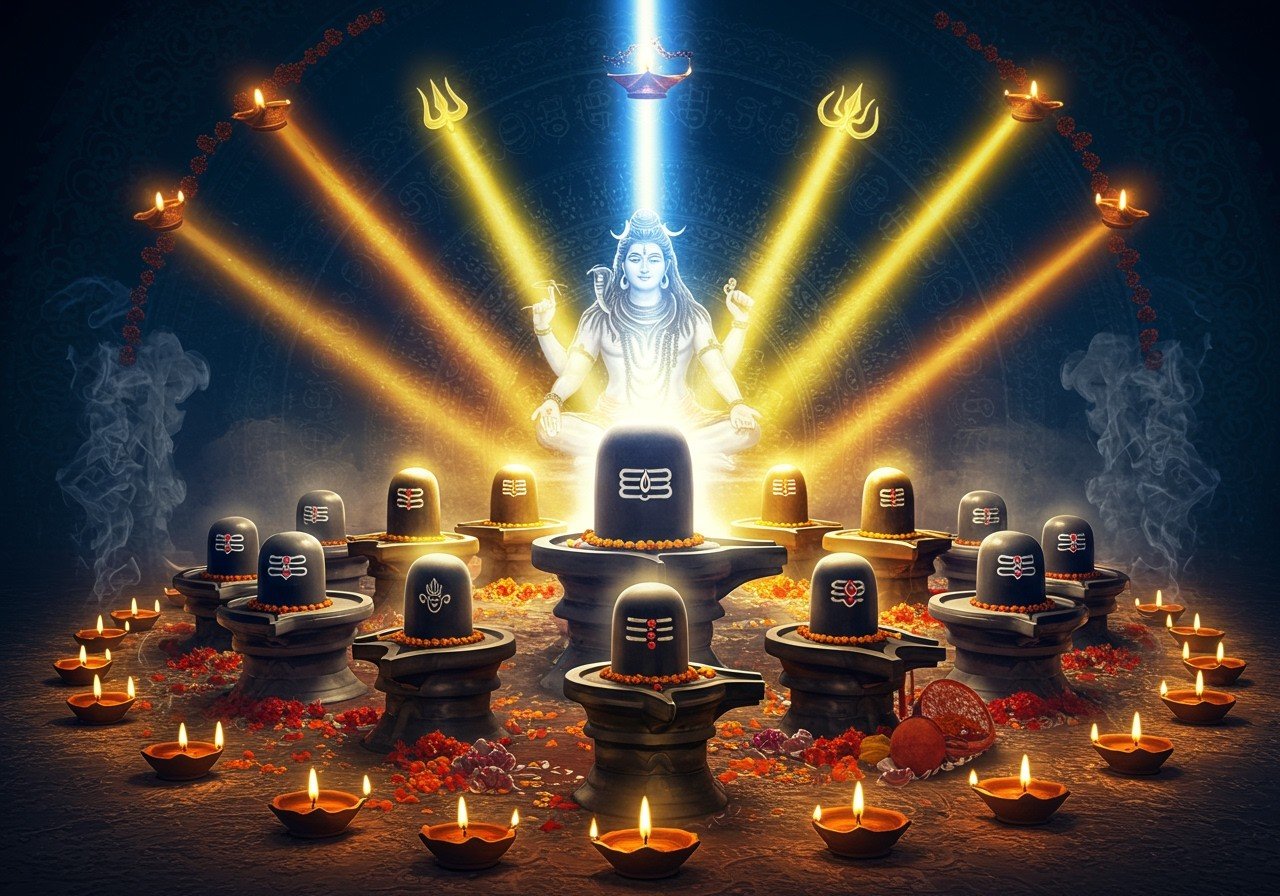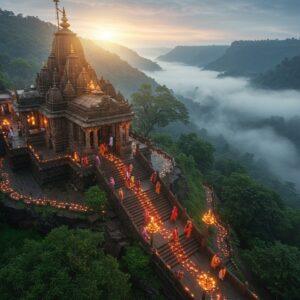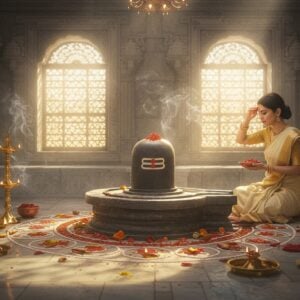
Embarking on a Jyotirlinga pilgrimage is a deeply spiritual experience for Hindus. It’s a journey to the twelve most sacred abodes of Lord Shiva, each radiating unique divine energy. This voyage connects you with ancient traditions, offering blessings and inner peace. It’s a cherished undertaking for those seeking spiritual solace and a deeper connection with their faith.
Delving into the Significance of Jyotirlingas
Rooted in ancient scriptures like the Shiva Purana, Jyotirlingas are believed to have emerged as radiant columns of light, signifying Lord Shiva’s omnipresence and boundless power. These twelve shrines, scattered across India, each hold unique legends and spiritual significance. They are not merely temples; they are living embodiments of Shiva’s eternal presence.
- Somnath (Gujarat): Known for its rich history and resilience, having been destroyed and rebuilt multiple times, this Jyotirlinga stands as a testament to unwavering faith. The temple’s location near the sea adds to its serene beauty.
- Mallikarjuna (Andhra Pradesh): Situated atop Shri Shaila Mountain, this shrine echoes with tales of Shiva and Parvati’s divine presence. The breathtaking views from the mountain add to the spiritual experience.
- Mahakaleshwar (Madhya Pradesh): Unique for its south-facing deity and the captivating Bhasma Aarti, this Jyotirlinga is a hub of vibrant devotion. The temple’s ancient architecture draws visitors from all corners of the world.
- Omkareshwar (Madhya Pradesh): Resting on an island in the Narmada River shaped like the sacred ‘Om’ symbol, this Jyotirlinga offers a serene and spiritually charged atmosphere. The natural beauty of the island adds to the temple’s charm.
- Kedarnath (Uttarakhand): Nestled high in the Himalayas, this Jyotirlinga is a part of the revered Char Dham Yatra, accessible only for six months a year. The challenging journey to reach the temple makes the pilgrimage even more rewarding.
- Bhimashankar (Maharashtra): Shrouded by lush forests in the Sahyadri hills, this Jyotirlinga offers a tranquil escape for devotees seeking peace and connection with nature. The surrounding natural beauty adds to the temple’s serenity.
- Kashi Vishwanath (Uttar Pradesh): Located in the sacred city of Varanasi, this Jyotirlinga holds immense significance in Hindu spirituality. The temple’s location on the banks of the Ganges adds to its sacred aura.
- Trimbakeshwar (Maharashtra): Close to the source of the Godavari River, this Jyotirlinga is associated with the river’s purifying powers. The temple’s architecture and history make it a fascinating place to visit.
- Vaidyanath (Jharkhand): Known for its association with healing and well-being, this Jyotirlinga draws devotees seeking blessings for good health and spiritual rejuvenation. The temple’s peaceful atmosphere promotes inner peace and reflection.
- Nageshwar (Gujarat): Situated near Dwarka, this Jyotirlinga is revered for its connection to Lord Shiva’s serpent form. The temple’s proximity to the sea creates a serene and spiritual ambiance.
- Rameshwaram (Tamil Nadu): Located on Rameswaram Island, this Jyotirlinga is closely linked to the epic Ramayana and Lord Rama’s devotion to Shiva. The island’s natural beauty enhances the pilgrimage experience.
- Grishneshwar (Maharashtra): Near Aurangabad and the Ellora Caves, this Jyotirlinga combines spiritual significance with historical and artistic richness. The temple’s location makes it easy to combine a spiritual journey with exploring ancient Indian art.
Crafting Your Jyotirlinga Pilgrimage: A Practical Guide
Planning a pilgrimage to these sacred sites requires careful consideration. Here’s a guide to help you prepare for your spiritual journey:
Choosing the Right Time
For most Jyotirlingas, the winter months (October to February) offer the most pleasant weather. However, Kedarnath, nestled high in the Himalayas, is accessible only from April/May to November. It’s advisable to avoid the monsoon season (June-September), especially in hilly areas.
Charting Your Course
- West & Central Circuit: This route encompasses Somnath, Nageshwar, Omkareshwar, Mahakaleshwar, Trimbakeshwar, Bhimashankar, and Grishneshwar. It allows for a convenient exploration of western and central India’s spiritual landscape.
- North & East Circuit: This path takes you to Kashi Vishwanath, Kedarnath, and Vaidyanath, offering a spiritual journey through northern and eastern India. It’s a pilgrimage that combines ancient traditions with breathtaking natural landscapes.
- Southern Circuit: This route includes Mallikarjuna and Rameshwaram, allowing you to experience the southern expressions of Shiva worship. It’s a journey that immerses you in the rich culture and traditions of South India.
Modes of Travel
Depending on your chosen route and personal preferences, you can travel by air, train, or bus. Keep in mind that reaching some temples, such as Kedarnath and Bhimashankar, involves trekking, adding an element of adventure to your pilgrimage.
Finding Accommodation
Many temples offer accommodation facilities for pilgrims. You can also find hotels and guesthouses near the temples, ensuring a comfortable stay during your spiritual journey. Booking in advance, especially during peak season, is highly recommended.
For a truly blessed pilgrimage, consider acquiring authentic puja items and samagri from Poojn.in. We offer a wide selection of high-quality products to enhance your spiritual experience.
Temple Etiquette and Rituals
Respecting temple customs is paramount for a fulfilling pilgrimage. Here are some essential guidelines:
- Dress Code: Traditional and modest clothing is highly recommended. Avoid wearing revealing or casual attire. Remember to dress respectfully to honor the sanctity of the temples.
- Abhishekam: This important ritual involves bathing the Shiva Lingam with milk, yogurt, honey, and other sacred offerings. It’s a deeply symbolic act of purification and devotion. Participate in this ritual with reverence and mindfulness.
- Temple-Specific Customs: Each Jyotirlinga has its own unique customs. For example, witness the mesmerizing Bhasma Aarti at Mahakaleshwar, cleanse yourself in the 22 Teerthams at Ramanathaswamy, or plan your visit to Trimbakeshwar during the Kumbh Mela for a truly unique experience.
Enhance your spiritual practices with authentic puja items from Poojn.in. We offer a wide variety of high-quality products to deepen your connection with the divine.
Tips for a Smooth Pilgrimage
- Comfortable Footwear: Wear comfortable walking shoes, as you’ll likely be doing a lot of walking and, in some cases, trekking. Proper footwear ensures a comfortable and enjoyable pilgrimage experience.
- Advance Bookings: For certain rituals like the Bhasma Aarti at Mahakaleshwar, advance booking is essential. Plan your itinerary accordingly to avoid disappointment. Booking ahead allows you to make the most of your spiritual journey.
- Local Transport: Be prepared to use various modes of local transport like trains, buses, or boats to reach some temples. Researching transportation options beforehand will streamline your pilgrimage.
- Health & Safety: Consult your doctor before embarking on the pilgrimage, especially if you have pre-existing health conditions. Carry necessary medications and take precautions to ensure a safe and healthy journey. Prioritizing your health will allow you to fully immerse yourself in the spiritual experience.
Poojn.in offers a diverse range of sacred idols, including exquisitely crafted Lakshmi murtis and Tara murtis, adding a touch of divinity to your home. Visit our store to explore our complete collection.
Jyotirlinga Darshan: More Than Just a Journey
A Jyotirlinga pilgrimage is a profound experience, a blend of devotion, adventure, and cultural immersion. It strengthens your faith, deepens your understanding of Hindu traditions, and creates memories that last a lifetime. Each step you take is a step closer to spiritual awakening and inner peace. May your Jyotirlinga Yatra be filled with divine blessings and unforgettable moments.
Frequently Asked Questions About Jyotirlinga Darshan
What does “Jyotirlinga” mean? A Jyotirlinga is a radiant representation of Lord Shiva, symbolizing his divine light and energy.
How many Jyotirlingas are there, and where are they located? There are twelve Jyotirlingas spread across India, each holding unique significance and legends.
What’s the importance of a Jyotirlinga pilgrimage? Visiting these sacred sites is believed to bring blessings, spiritual growth, and purification. It’s a journey of deep spiritual significance.
What is the benefit of chanting Jyotirlinga mantras? Chanting mantras helps focus the mind, deepen spiritual awareness, and connect with divine energy.
Is there any specific preparation for a Jyotirlinga visit? Maintaining a pure mind and body, wearing clean clothes, and bringing offerings are recommended. Meditating and chanting mantras can also enhance the experience.
Find everything you need for your spiritual practices at Poojn.in. We offer a wide range of puja samagri, including Trishuls and copper snakes for your Shiva Lingam. Explore our collection today!


